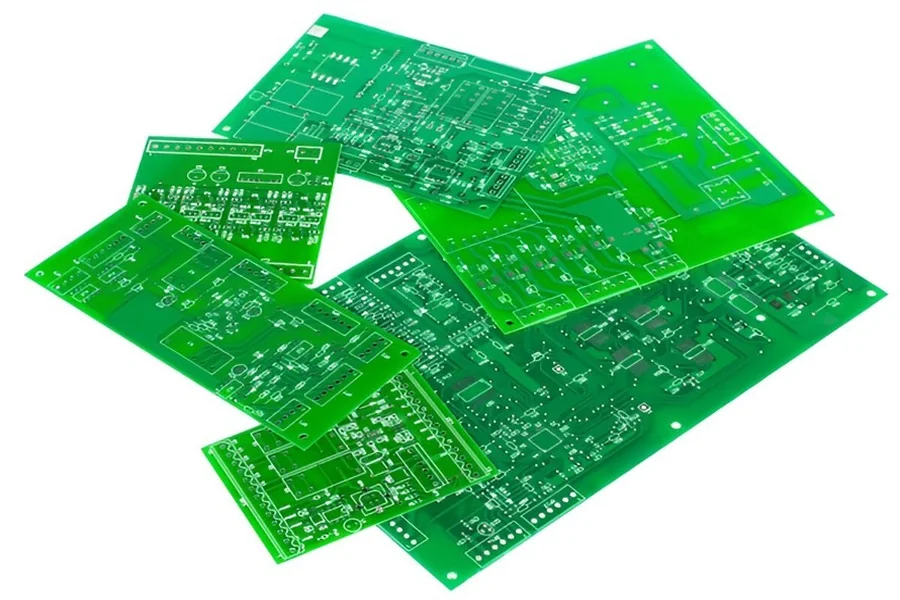An FR4 PCB is a printed circuit board made using FR4 as the base material. FR4 stands for “Flame Retardant 4,” which refers to a fiberglass-reinforced epoxy laminate that is known for its excellent mechanical strength, electrical insulation, and heat resistance. As the most widely used material in PCB manufacturing, FR4 offers a balanced combination of affordability, durability, and performance, making it suitable for a vast range of electronic devices.
Whether it’s a simple consumer gadget or a complex industrial control system, FR4 PCBs provide a dependable platform for mounting and connecting electronic components. Their ability to maintain structural integrity in a variety of environments has made them the default choice for many applications across different sectors.
Contents
Key Properties of FR4 Material
The success of FR4 PCBs lies in the inherent properties of the FR4 substrate. It is a composite material made by weaving fiberglass cloth with an epoxy resin binder. This composition gives it high mechanical strength and thermal stability, allowing it to withstand the stresses of manufacturing and operation.
FR4 material has excellent dielectric properties, which means it can insulate electrical signals effectively. This makes it ideal for applications that require reliable signal transmission without interference. It also resists moisture absorption, which ensures consistent electrical performance even in humid environments.
In addition, FR4 has a relatively high glass transition temperature (Tg), typically around 130–140°C, though high-Tg versions are also available for more demanding applications. This feature makes FR4 PCBs suitable for surface-mount technology (SMT), wave soldering, and other thermal processes.
Applications of FR4 PCBs
FR4 PCBs are used in a wide range of electronic products. In consumer electronics, they are found in smartphones, laptops, televisions, and wearables. In automotive electronics, FR4 PCBs are used in dashboards, lighting systems, and engine control units due to their ability to handle vibration and moderate heat.
Medical devices also benefit from FR4 PCBs in areas such as diagnostic equipment, monitoring devices, and portable health tools. Industrial automation systems, including motor controllers and sensors, rely on FR4 boards for their ruggedness and electrical reliability.
Telecommunication devices, networking equipment, LED lighting systems, and power supplies are other common domains where FR4 PCBs are frequently used. Because of its cost-effectiveness and ease of processing, FR4 continues to dominate both low- and high-volume PCB production.
Types of FR4 PCBs
FR4 PCBs come in several types based on design complexity and application needs. These include:
- Single-sided FR4 PCB – Ideal for simple circuits with components mounted on one side.
- Double-sided FR4 PCB – Offers more design flexibility, allowing components and traces on both sides of the board.
- Multilayer FR4 PCB – Suitable for complex electronics requiring multiple signal layers and power/ground planes.
Depending on the electrical and mechanical requirements, the thickness of the FR4 board can be customized, usually ranging from 0.2mm to 3.2mm or more.
FR4 PCB Design Considerations
Designing an FR4 PCB requires thoughtful planning to ensure optimal performance and manufacturability. Engineers must consider trace width, spacing, via placement, and thermal management, especially in multilayer designs. The thermal conductivity of FR4 is relatively low (about 0.3 W/m·K), so components that generate significant heat may need additional cooling strategies like thermal vias or heat sinks.
Controlled impedance routing is possible on FR4, but the dielectric constant (typically 4.2–4.8) must be taken into account for high-speed or RF designs. Signal integrity can be improved by careful stack-up design and grounding techniques.
FR4 PCBs are compatible with a variety of surface finishes, including HASL, ENIG, OSP, immersion silver, and lead-free options, depending on the assembly process and environmental requirements.
Cost and Production Advantages
FR4 PCBs strike the perfect balance between performance and cost. The material is readily available, easy to process, and supports a wide range of board thicknesses, copper weights, and surface finishes. This versatility allows FR4 PCBs to be mass-produced quickly and economically, making them a popular choice for startups and established manufacturers alike.
Moreover, FR4’s mechanical strength makes it less prone to warping or cracking during manufacturing or end-use. It can be laser cut, milled, drilled, and plated with high precision, enabling consistent quality in high-volume production.
Choosing the Right FR4 PCB Manufacturer
If you’re planning a new product or upgrading an existing design, selecting an experienced fr4 pcb manufacturer is essential to ensure quality, performance, and reliability. A reliable manufacturer will provide engineering support, material selection advice, stack-up optimization, and prototyping services. They will also offer the manufacturing flexibility to accommodate everything from single-sided boards to complex multilayer configurations.
Look for a partner with state-of-the-art fabrication equipment, tight quality control processes, and industry certifications to support your technical and compliance needs. Whether you’re producing thousands of consumer electronics boards or a custom industrial solution, a trusted FR4 PCB manufacturer can help bring your design to life with precision and efficiency.

